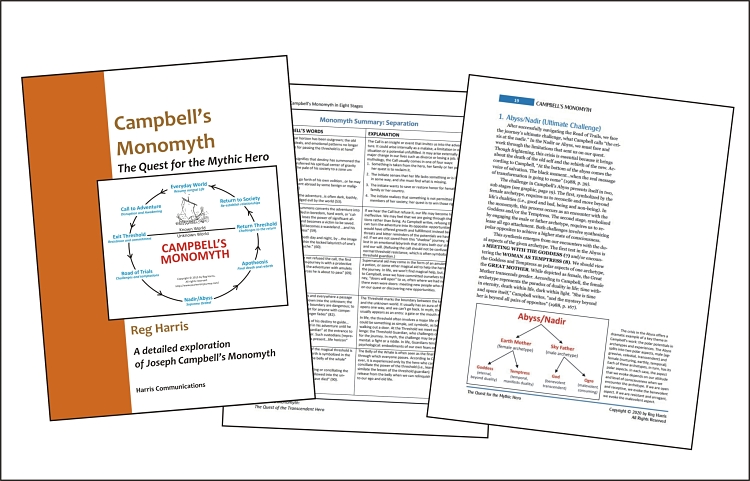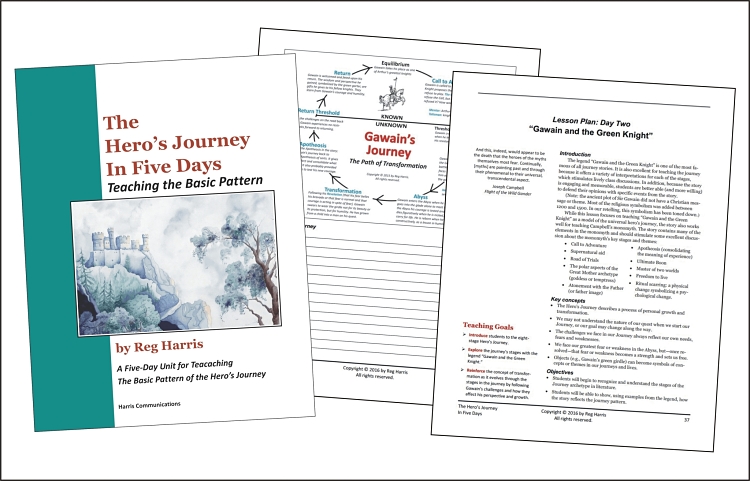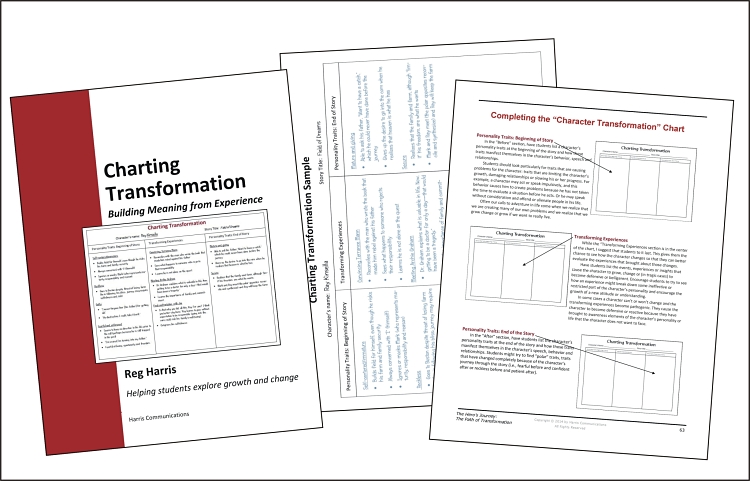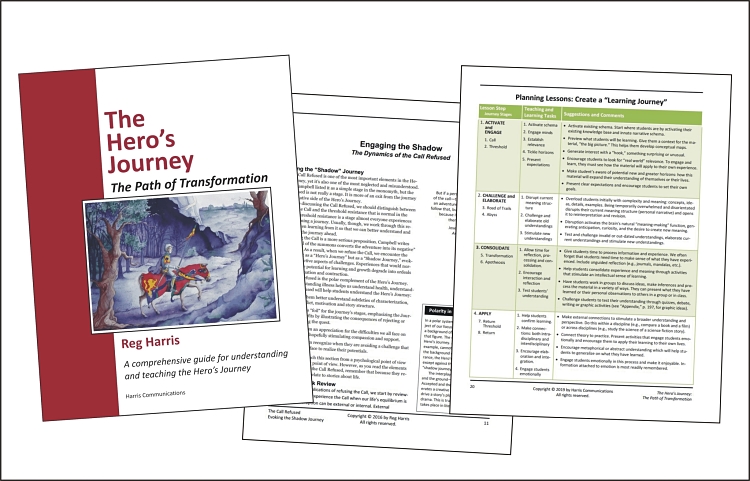
Campbell’s Monomyth: The Quest for the Mythic Hero
Campbell’s Monomyth: The Quest for the Mythic Hero offers a concise, but thorough examination of Joseph Campbell’s monomyth, its symbolism and its themes.
Campbell explored the monomyth, known more commonly as the Hero’s Journey, in his 400-page book The Hero with a Thousand Faces (1949). Despite it’s complexity and academic focus, Hero became the authoritative analysis of the journey process. Our 72-page guide simplifies, illuminates and expands on Campbell’s work. The guide is divided into three sections:
 Section One covers the three-stage Rite of Passage, which Campbell called the “nuclear unit” of the monomyth. Campbell believed that the transformation of consciousness triggered by the Rite of Passage illustrates the growth cycle in the monomyth.
Section One covers the three-stage Rite of Passage, which Campbell called the “nuclear unit” of the monomyth. Campbell believed that the transformation of consciousness triggered by the Rite of Passage illustrates the growth cycle in the monomyth.
Section Two is a thorough analysis of the monomyth, its elements and stages. We group Campbell’s 17 elements into an easily-understood, eight-stage model that is true to Campbell’s thesis and vision. The analysis focuses on his three key themes:
– the transformation of consciousness brought about by the journey process,
– polarity and polar potentials in the monomyth, and
– the importance of our attitude in successfully navigating challenges.
Section Three contains supplementary articles. First, a brief history of research into the hero’s journey pattern gives you a broader perspective on the evolution of the journey pattern. This is followed by the rational for consolidating Campbell’s 17-element model into a concise 8-stage model. Finally, we briefly exploration the challenges of understanding Campbell and applying his concepts to teaching and everyday life.
This guide is rich with charts and graphics that illustrate the monomyth and help you better understand its most complex elements. For a detailed look inside, see “Contents” below.
TAKE A CLOSER LOOK
ANNOTATED CONTENTS
Introduction to Campbell and the Monomyth: The guide opens with an introduction to the monomyth and its three key themes followed by an overview of Joseph Campbell, his popularity and his impact.
Ritual and Rites of Passage: Campbell called the rite of passage the “nuclear unit” of the hero’s journey because it encapsulated the three stages in the process of transformation that are the foundation of the Hero’s Journey process. Understanding the transformative power of the rite of passage will enrich your understanding the monomyth as a whole.
The Monomyth in Eight Stages: This comprehensive look at Campbell’s monomyth groups Campbell’s 17 original elements into eight manageable stages and explores the monomyth’s archetypes, symbolism and themes. It also examines the pattern’s psychological foundation, and includes “The Wisdom of Polarity,” which explores one of the monomyth’s major themes: polar reconciliation. Numerous charts and tables will aid your understanding.
History of Research into the Hero’s Journey: Joseph Campbell was not the first scholar to explore the pattern of the Hero’s Journey. This article scans the history of research into the Hero’s Journey from the mid 1800s until Campbell.
Consolidating the Monomyth: Campbell wrote that the variety of elements and changes in the monomyth “defy description.” He includes 17 elements in his analysis in The Hero with a Thousand Faces and more than a dozen more in his summary. Fortunately, these elements can be grouped into eight basic stages. Our analysis uses this eight-stage model while still covering all of Campbell’s elements and maintaining his focus on the transformation of consciousness.
The Challenges of the Monomyth: Critics of Campbell point to four major difficulties with his work. Understanding these difficulties can help you maintain the perspective you need to put the themes and dynamics of the monomyth into a useful context.
Illustrative Charts: These four charts illustrate various views of the monomyth. While intended primarily for educators, they will help anyone better understand the monomyth’s general pattern and the complexities it contains.
References and Recommendations: For readers interested in further study of the Hero’s Journey and its related themes, we include both the references we cite in this publication and a long list of other books and websites that are worth investigating.
SUPPORT AND GUARANTEE
SUPPORT: I fully support all of my publications. If you have questions, problems, comments or complaints, please let me know. I am also happy to answer questions or offer suggestions about your specific application of my materials.
GUARANTEE: If within 30 days of purchase, you decide that you are unhappy with your purchase, contact me and I will issue an immediate refund. I ask only that you tell me what the problem is so that I can try to correct it.
About the Author
Reg Harris has 33 years of experience teaching at every level from middle school to college post-graduate programs. He began using the Hero's Journey in the classroom in 1975, and he has been researching and writing about the Hero's Journey since 1986. He has an MA in psychology, with a focus on the transformative processes driving the journey experience.
His original teaching guide, The Hero's Journey: A Guide to Literature and Life, won the 2002 National Youth Storytelling "Teaching and Coaching" Pegasus Award. That guide and its revisions are currently being used by schools in 42 states and 17 countries.
He has presented dozens of workshops, including at state conferences in Oregon and California, and, in 2007, he was a featured speaker at the 30th Anniversary Celebration of the original Star Wars.
For the story of his exploration of the Hero's Journey, see "My 40-Year Journey into the Hero's Journey".


